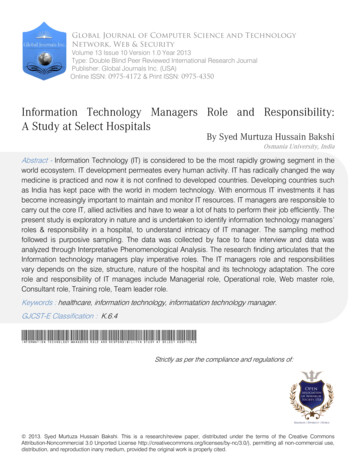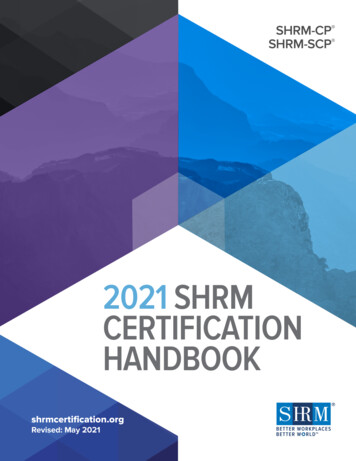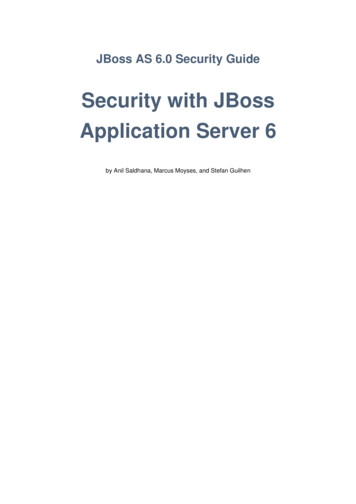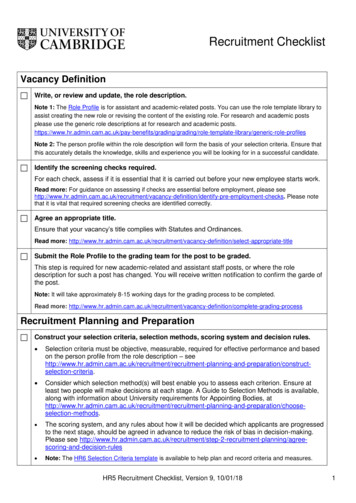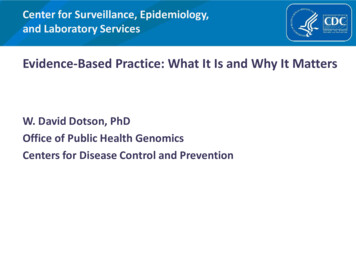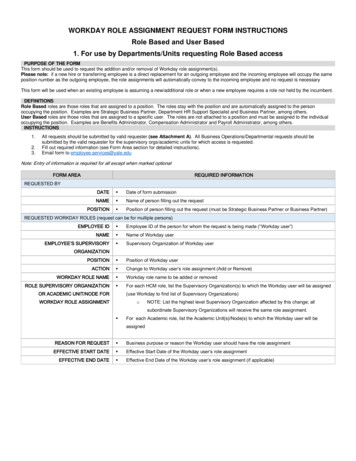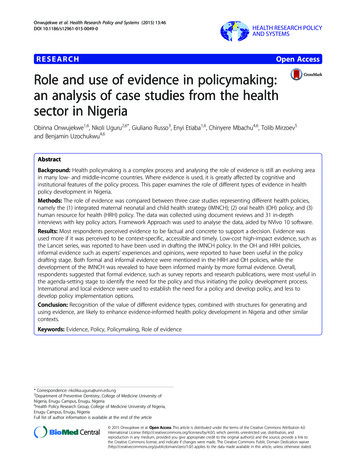
Transcription
Onwujekwe et al. Health Research Policy and Systems (2015) 13:46DOI 10.1186/s12961-015-0049-0RESEARCHOpen AccessRole and use of evidence in policymaking:an analysis of case studies from the healthsector in NigeriaObinna Onwujekwe1,6, Nkoli Uguru2,6*, Giuliano Russo3, Enyi Etiaba1,6, Chinyere Mbachu4,6, Tolib Mirzoev5and Benjamin Uzochukwu4,6AbstractBackground: Health policymaking is a complex process and analysing the role of evidence is still an evolving areain many low- and middle-income countries. Where evidence is used, it is greatly affected by cognitive andinstitutional features of the policy process. This paper examines the role of different types of evidence in healthpolicy development in Nigeria.Methods: The role of evidence was compared between three case studies representing different health policies,namely the (1) integrated maternal neonatal and child health strategy (IMNCH); (2) oral health (OH) policy; and (3)human resource for health (HRH) policy. The data was collected using document reviews and 31 in-depthinterviews with key policy actors. Framework Approach was used to analyse the data, aided by NVivo 10 software.Results: Most respondents perceived evidence to be factual and concrete to support a decision. Evidence wasused more if it was perceived to be context-specific, accessible and timely. Low-cost high-impact evidence, such asthe Lancet series, was reported to have been used in drafting the IMNCH policy. In the OH and HRH policies,informal evidence such as experts’ experiences and opinions, were reported to have been useful in the policydrafting stage. Both formal and informal evidence were mentioned in the HRH and OH policies, while thedevelopment of the IMNCH was revealed to have been informed mainly by more formal evidence. Overall,respondents suggested that formal evidence, such as survey reports and research publications, were most useful inthe agenda-setting stage to identify the need for the policy and thus initiating the policy development process.International and local evidence were used to establish the need for a policy and develop policy, and less todevelop policy implementation options.Conclusion: Recognition of the value of different evidence types, combined with structures for generating andusing evidence, are likely to enhance evidence-informed health policy development in Nigeria and other similarcontexts.Keywords: Evidence, Policy, Policymaking, Role of evidence* Correspondence: nkolika.uguru@unn.edu.ng2Department of Preventive Dentistry, College of Medicine University ofNigeria, Enugu Campus, Enugu, Nigeria6Health Policy Research Group, College of Medicine University of Nigeria,Enugu Campus, Enugu, NigeriaFull list of author information is available at the end of the article 2015 Onwujekwe et al. Open Access This article is distributed under the terms of the Creative Commons Attribution 4.0International License (http://creativecommons.org/licenses/by/4.0/), which permits unrestricted use, distribution, andreproduction in any medium, provided you give appropriate credit to the original author(s) and the source, provide a link tothe Creative Commons license, and indicate if changes were made. The Creative Commons Public Domain Dedication o/1.0/) applies to the data made available in this article, unless otherwise stated.
Onwujekwe et al. Health Research Policy and Systems (2015) 13:46BackgroundThere is an increasing recognition that strong and effective health systems that are evidence-informed in theiroperations are necessary to achieve continued improvement in health outcomes in an efficient and equitablemanner [1, 2]. The incorporation of relevant highquality research evidence into the health policy processhas been outlined as a key strategy for improving healthsystems worldwide [3–5]. Thus, evidence-informed decision making has been promoted to aid policy development in most countries [6, 7].The capability of health systems in low- and middleincome countries to deliver services to the people is severely constrained by polices that are borne out of trialand error rather than evidence [8, 9]. However, policymaking processes do not necessary always follow theclear and straightforward logic of scientific enterprise[10] and some authors have stated that, when evidenceis used by policymakers, it is greatly affected by cognitiveand institutional features of the political process [11, 12].Health policymaking, a central element of sustainablehealth systems, involves a complex process of interactions between policy actors with different powers, interests and agendas [13]. Therefore, ensuring the uptake ofevidence for more effective policy and practice is a challenge for health systems strengthening in most low- andmiddle-income countries [14].Evidence has been described in the literature as “whatconstitutes actual or asserted facts planned for use insupport of a conclusion” [15]. Evidence from researchcan improve the health policy process, by identifyingnew issues for the policy agenda, informing decisionsabout policy content and direction, and evaluating theimpact of policy [16–19]. While some authors regardevidence as mostly scientifically-driven facts, othersargue that evidence can be formal (such as published research or program monitoring and evaluation) or informal(such as personal experiences, received wisdom and opinions) depending on its process of generation [14, 20, 21].Analysing the role of evidence in health policymakingis still an evolving area of research. Whereas the focus ofprevious studies on evidence-informed policymaking hasbeen on the extent to which policies are informed byevidence, there is limited understanding of the relativevalue of different types of evidence in health policy decisions across different policies and varied contexts.This paper compares the contributions of differenttypes of evidence in the development of three healthpolicies in Nigeria and explores the contextual influences which affected the utilization of evidence in developing these policies. The results of our study should beof interest and relevance to the key health policy actors(such as policymakers, academia, civil society organizations) who are involved in developing and implementingPage 2 of 12health policies in Nigeria and similar contexts, and areinterested in better understanding and ultimately enhancing the use of evidence in health policy development.The Nigerian health system and policymakingNigeria operates a three-tier level of healthcare – tertiary,secondary and primary. Provision of healthcare inNigeria is a concurrent responsibility of the three tiers ofgovernment – federal, state and local government. However, because Nigeria operates a mixed economy, privateproviders of healthcare have a visible role to play in healthservices delivery [22, 23]. The operational levels have different but sometimes overlapping roles and responsibilities. The Federal Ministry of Health (FMOH) providestertiary healthcare services as well as technical support tothe state and local government health authorities. Theyalso regulate the activities of the lower levels. The StateMinistries of Health are statutorily responsible for theprovision of secondary healthcare services and theprovision of technical support for and regulation of primary healthcare services, while the local governments areresponsible for the implementation of primary healthcareand provision of services at the primary care level [24].In response to the very low ranking of the Nigerianhealth system in the year 2000 [25], the countryembarked on a Health Sector Reform Program (HSRP)in 2003. The Federal Ministry of Health and development partners such as WHO, UNICEF, Partnership forTransforming Health Systems (DFID), and the UnitedNations Population Fund, among others, initiated anddeveloped different policies and strategies which aim tostrengthen and improve the functioning of the healthsystem to become more equitable and efficient in servicedelivery and consequently improve health outcomes.Three of the key policies and strategies that were developed are the Human Resources for Health (HRH) policy,the Oral Health (OH) policy and the Integrated Maternal, Newborn and Child Health (IMNCH) strategy.These were the subjects of investigation of the presentstudy, which sought to understand the role of evidencein policymaking.In Nigeria, the FMOH is responsible for policymakingand health policies are made at that level by senior government officials with significant contributions frompartners and stakeholders in the public and private sectors. Although the State Ministries of Health can makepolicies at their level, most polices at the state level areadapted from the national level policies and made to fitthe state’s context. A formal process of problem identification, agenda setting, policy formulation, and implementation is used in the policymaking process. However,these stages are usually interwoven with a series of advocacy meetings, stakeholder consultations, and lobbying.The National council on health and the Federal Executive
Onwujekwe et al. Health Research Policy and Systems (2015) 13:46Council must give the final approval on all health-relatedpolicies before they can be implemented [24].The recognition of the usefulness of evidence in policymaking for effective implementation of the country’sHSRP evidence-based policymaking initiatives wereestablished. One such example is the Nigerian EvidenceBased Health Initiative which was developed to inform aplan to support a fair and effective primary healthcaresystem in Nigeria. However, this program’s focus on onlytwo States limited the uptake of research to inform policy in other parts of the country [26].Amidst political influence of the ruling party in policymaking, evidence from situation analysis gets used inagenda setting [27]. However, the use of research evidence to inform policy in clinical decision-making inteaching hospitals and in policy implementation inNigeria has been observed to be very minimal or completely absent [26, 28].MethodsThis section gives an overview of the study design andbackground, describing the conceptual framework used inthe study and giving a brief description of the three policies and the data collection and analytical methods used.The conceptual framework (Figure 1) has informed theidentification of the key information areas for the data collection and analysis in this study. Different types of evidence exist in the literature and they can be grouped intoPage 3 of 12formal and informal [29]. For the purpose of this study,evidence was defined as information – both formal andinformal – that can be used in supporting (or otherwise) aconclusion or indicating whether an assumption or proposition is true or valid. Examples of formal evidenceinclude peer-reviewed research reports and health management information system and statistical data, whereasexamples of informal evidence include expert knowledgeand experiences as well as outcomes of stakeholder consultations. Evidence can be used in decisions either directly (e.g. by indicating effectiveness of a particularintervention within the same or similar context) or indirectly (e.g. by affecting actors’ values and experiences).As shown in Figure 1, the role of evidence in healthpolicies is perceived as interplay between evidence (i.e.the process of evidence generation, dissemination, anduse) and policy processes (agenda setting, developmentand implementation) [20]. The policy actors determinethis interplay through their involvement in evidence andpolicy processes, affected by their agendas and practices[17, 18]. This interplay is affected by the nature of thepolicy issue (for example, whether the issue is politicallyand socially sensitive and/or controversial), the contentsof a specific policy (i.e. policy options proposed), and thetypes and characteristics of evidence available around aspecific policy [4, 18]. All of the above occurs within thewider context, which includes different national andinternational influences [17].Figure 1 Framework for assessing the role of evidence in policy development.
Onwujekwe et al. Health Research Policy and Systems (2015) 13:46Study settingThe study was undertaken in Nigeria, a West Africancountry with a population of about 170 million, andconducted at the Federal Capital Territory of Nigeria,where all national policies are made.Study designThis was a retrospective cross-sectional qualitative studyusing a case study approach. Three cases were selectedand used to analyse the role of evidence for health policydevelopment in Nigeria. In this study, a case was definedas a health policy or strategy developed for an area ofhealthcare services (e.g. non-communicable disease, maternal health, and child health) or a component of thehealth system (e.g. human resources for health).The cases were purposively selected based on the general criteria that the policy and/or strategy was established within 10 years from the time of the study toenhance recall, and that it was an area of interest to theMinistry of Health. In addition, the policies and/or strategies were selected to represent the following threeareas: (1) an area of international prominence (IMNCHstrategy, 2007); (2) a neglected area (OH policy, 2012);and (3) an aspect/component of the health system (HRHpolicy, 2006).Description of the policiesIMNCH strategyThe Nigerian IMNCH strategy was developed andlaunched in 2007. Its overall objective is to reduce maternal, newborn, and child morbidity and mortality inline with the millennium development goals (MDGs) 4and 5. The IMNCH policy was largely a product of aglobal agenda to improve maternal and child health inthe MDGs. The political transition to democracy, accompanied by an improvement in the budgetary allocation to health, provided a window of opportunity toscale-up high impact interventions in maternal and childhealth in the country [30]. The strategy was developedwithin the framework of the National HSRP to addressthe most common conditions responsible for maternaland under-5 mortality in Nigeria. Its development wassupported by a Partnership Grant from the Partnershipfor Maternal, Newborn and Child Health in 2007, inwhich the FMOH was tasked with the responsibility ofcoordinating actions and partners to accelerate the reduction in maternal, newborn and child mortality andinvolved academics, health professionals, civil society organizations (CSOs), and development partners in thepolicy development processes.OH policyAfter several failed attempts in the 1990’s and early2000’s at developing and obtaining final approval for anPage 4 of 12OH policy, a National OH Policy was developed and finally adopted in November 2012 in Nigeria. It isintended to achieve optimal OH for at least 50 % ofNigerians through five strategies namely by (1) sustainable awareness creation, (2) early detection and prompttreatment of oral diseases using evidence-based interventions, (3) strategic research, (4) workforce development, and (5) co-ordination of OH activities includinginstitutionalization of modern dental practices. The policy document was developed through multi-stakeholderparticipation of experts in OH, WHO, and medical practitioners in the three tiers of the health system [31].HRH policyThe HRH policy document was first developed in 2006by a variety of stakeholders in health made up of publicand private sector players following world health reportsdevoted to addressing the global HRH crisis [31]. An ongoing national health sector reform program also emphasized the poor maternal mortality ratio and underfive mortality rate as well as other anomalies in thehealth system and was geared towards improving thecountry’s poor health indices. The policymakers usingthe national reform and the positive political climate asa platform were motivated to develop the policy to address a number of key challenges in HRH, includingplanning, recruitment, production, utilization, and retention of health workers.Data collection methodsThe data was collected between December 2012 and July2013. Two methods were used to collect data for thisstudy: document review and in-depth interviews.Document reviewDocument reviews were used to identify the differentevidence available around a particular policy and informthe development of the initial list of respondents for thestudy. A total of 27 documents were reviewed, coveringall three case studies. Documents included in the reviewwere key policy statements, policy dissemination documents, published consultancy reports, published and unpublished monitoring and evaluation reports, academicpublications, research reports, policy briefs, grey literature (e.g. consultancy reports), and health statistics including health management information system reportsand country-level publications on websites of the relevant agencies (e.g. FMOH, WHO). In order to retrieverelevant national documents and academic publications,an extensive search was carried out on academic databases (such as PubMed and Cochrane), institution/organization libraries and search websites (such as Google scholar), using key words such as Nigerian healthpolicy, human resources for health policy, integrated
Onwujekwe et al. Health Research Policy and Systems (2015) 13:46Page 5 of 12maternal and child health policy, and oral health policy.Expert recommendations and citation pearling were alsoused to identify and retrieve documents.Once the documents were identified, the executivesummary/abstract of each document was reviewed toidentify its relevance to the particular policy. The inclusion of documents in the review was guided by relevanceof the evidence to the policy issues as perceived by researchers and availability of the document during the timing of the policy development. Relevant information onextent and types of evidence used in policy developmentand key contextual influences on evidence use was extracted from the documents and summarized according tothe key components in the conceptual framework (evidenceprocess and use, context, actors, and policy process). Astandardized proforma with these key components wasused for the extraction, which was structured around thefour components of the conceptual framework.reached for the respective case studies. Where key actorswere not available for interviewing (e.g. retired), their immediate colleagues possessing knowledge of the policydevelopment were approached. All interviews were audiorecorded with informed consent obtained prior to theinterview (Table 1).In-depth interviewsData analysisIn-depth interviews were conducted to explore perceptions of usefulness of evidence in policy/strategy development and the key contextual influences on evidenceuse for policymaking. Detailed information was collectedfrom policy actors such as government policymakers,representatives of CSOs, health workers, developmentpartners, and academics. The list of respondents for interviews was developed using purposive sampling (basedon their role in developing health policies and theiravailability for interview) and informed by review of keypolicy documents around each of the three case studies,researchers’ knowledge of the actors’ involvement in policy development, and initial meetings with the key stakeholders (as part of consultation in selecting a policywithin each case study). The list of respondents was continuously updated throughout data collection using thesnowballing technique.The interviews were guided by a semi-structured question guide focused on respondents’ role and the understanding and perceptions of the role of different types ofevidence in health policy development. Most interviewswere face-to-face and, in situations where respondentscould not be reached within the interview period, telephone interviews were conducted (two interviews in theOH policy case study and one in the IMNCH case studywere conducted by telephone). The respondents were assured of confidentiality and anonymity during recruitment. This enabled the respondents to give extensiveinformation on their knowledge, experiences and perceptions on role of evidence in policy formulation.A total of nine policy actors were interviewed for OH,10 for IMNCH, and 12 for HRH. A summary of participant types and number interviewed is presented in Table 1.New participants were interviewed until saturation wasA thematic framework analysis was performed, which included stages of familiarization with the data, coding,indexing and charting data, and mapping and interpretation [32]. The findings from the various documentsreviewed were synthesized based on the thematic areasand analyzed. All audio recorded interviews were transcribed by the interviewers. A coding tree was used tocode the transcriptions according to relevant thematicareas, such as (1) respondents perception of evidence,(2) types and characteristics of evidence, (3) role of different types of evidence, (4) actors, and (5) contextualinfluences on evidence and policy processes. NVivo10software was used to aid the data coding and analysis.Table 1 Participant types and number interviewedParticipant typesIMNCHOHHRHPublic policymakers and government officials535Academics/Researchers141Professional groups101Civil society organizations112Development partners212Health workers001Total10912Ethical considerationsEthics approval for this study was obtained from theUniversity of Nigeria Teaching Hospital ethical reviewboard, before the commencement of the in-depth interviews. Each respondent also gave informed consent before the in-depth interviews were undertaken.ResultsThis section gives a brief description of the policy/strategydevelopment context for the three case studies and highlights similarities and differences between the three casestudies in the policy development process. It also presentsthe types of evidence used in policy/strategy developmentand the influences of context, respondents’ understandingof the concept, and robustness of evidence on evidenceuse in development of the policies and strategy.Context of policy/strategy developmentBased on responses obtained from our interviews, weobserved that the three policies were developed amidst
Onwujekwe et al. Health Research Policy and Systems (2015) 13:46different national and international issues. The IMNCHand HRH policies were already familiar and well discussed topics, with previous policies developed. However, the OH policy was regarded as neglected withuncoordinated and haphazard attempts at previous policy developments, which failed after the first OH policyin 1995. All three policies generally followed a formalpolicy development process which consisted of agendasetting, information gathering, policy formulation, approval, and review and validation. Our respondents’,however, reported that this process did not follow a linear fashion but was iterative and interspersed with stagesof lobbying and advocacy, especially with the HRH policy (Table 2).Analysis of interview data revealed that various factorsinfluenced the different stages of policy development.Three factors influenced the agenda setting stage of allthree policies: global as well as national considerationsand policy framework. The national policy guideline/framework influenced the drafting of IMNCH and HRHpolicy documents, though this is not the case in the OHpolicy formulation, where real-life experiences affected thepolicy drafting and revision stages. In all three policies,and in the OH policy case in particular, both national andglobal considerations had substantial influences on theprobability of policy being approved. The internationalclamour for the need of an OH policy by global actors, forexample by WHO, and the persistence of one specific national actor, are all factors that were found to have influenced the likelihood of policy approval.Respondents’ perception of evidenceAcross the three case studies, participants perceived evidence processes as a formal process of gathering information to inform decisions. However, different stakeholdersappeared to adopt diverse and often conflicting views ofwhat constitutes evidence, as their understanding of thePage 6 of 12concept seemed to reflect their personal experiences. Wedid not identify a single dominant common definition of‘evidence’, but rather a plurality of interpretations, but thiswas not highlighted as an issue of concern by the interviewees. In some cases, perceptions of evidence werebroad and in others it was linked synonymously with research, albeit with less certainty about the meaning of theword ‘evidence’. Most respondents gave a definition of evidence which is synonymous with research.“My understanding of evidence use is having concretedata that has been collected through a process that isconsidered legitimate and you give reference to thatdata. It could have been a survey.” (HRH, CSO; OH,Academia)However, a minority of respondents also gave abroader definition of evidence, suggesting that this canalso include informal types:“Evidence is like a mere idea that have been harvestedand shows where you are, and informs what youintend to subsequently do. In this context, it shouldprove there is a situation.” (HRH, Policymaker)Types of evidence usedTen types of evidence were perceived by the respondentsas being used to develop policies within all three casestudies. These are survey reports, research publications,national and international policy documents, systemicreview reports of programs, proceedings from expertconsultation meetings, experience and opinions of experts and policymakers, epidemiological reports anddocuments on lessons learned from international experiences, and best practice guidelines (Table 3).Both formal and informal types of evidence informedthe development of the three policies, though ourTable 2 Context of development of the three cases under study (IMNCH, OH, and HRH)IMNCH strategyOH policyHRH policyHad high international prominence andwas key in most national discoursesRegarded as a neglected area in thehealth sector of the countryThis was a key aspect in most national and internationalpolitical debates as it cuts across all aspects of healthThe need to produce a comprehensive planof action to address the high maternal andchild mortality indices in the country healthThis policy was thus developed basedon the high oral disease burden in NigeriaThe need for an integrated strategy topromote continuum of care for motherand childThe desire of the relevant stakeholders tostandardize practice, organization anddelivery of oral health services acrossthe countryThis policy was developed based on the inadequateproduction, mal-distribution of the available workforce,and the increasing brain drain resulting in shortage ofcritically needed healthcare professionalsFormal policymaking process (agenda setting to development and final approval of policy)Existing strategic framework (nationalhealth sector reform plan) was usedto guide policy developmentNo coordinated strategy framework for oralhealth servicesFailure of previous attempts to develop anoral health policyExisting strategic framework (national health sectorreform plan) was used to guide policy development
Onwujekwe et al. Health Research Policy and Systems (2015) 13:46Page 7 of 12Table 3 Types of evidence used across the three case studiesTypes of evidence usedCase studiesIMNCHOHHRHSurvey reports, situation analysis, national data sets, institution data sets Research publications (international and national) Existing policy documents (national) X Systematic review reports XXEpidemiological reports XXProceedings of expert consultation meetings Lessons from international experience and best practice guidelines (policies and publications) XHealth management and information system dataXXXMonitoring and evaluation reportsXXXExpert and policymaker opinions and experiences analysis shows that the formal types of evidence played alarger role. The quote below depicts this statement.“Basically, evidence from program implementation,research findings, program reports, I think this are forme the most important.” (IMNCH, Policymaker)As shown in Table 3, formal evidence (national andinternational) played a more prominent role in the development of all three policies. Informal evidenceseemed to play a role in HRH and OH policies morethan in IMNCH policy.Amongst all evidence used, the one considered to be themost important by the majority of respondents across thethree cases were findings from national surveys (such asbaseline surveys or situation analysis) because they werecontext-specific, timely and gave a true picture of whatwas on the ground. Most respondents felt that the methodological rigor, availability of survey reports, relevance,and ease of obtaining the information from these surveyswere also what made it especially useful.“The evidences we had were based on researchactivities and surveys which are national in theirscope, and then they were quite extensive andrigorous” (OH, Academia).However, there were a few disparate views as regardslabelling this singular type of evidence as the most important, because according to the respondents, “all typesof evidence generated complements each other, we cannotsay one is the best” (HRH, Academia). For example, inthe HRH case study, evidence obtained from opinionsand experiences of experts in the field were consideredimportant by some respondents, especially the policymakers. They claimed that this form of evidence helpedto augment the findings from the baseline survey. InIMNCH, published research findings, especially thosefrom a series of publications showing evidence of highimpact interventions for maternal and child survivalpublished in the Lancet [33], were important by givingan insight into best practices for maternal and childhealth issues and added to the body of evidence indeveloping the policy
Nigeria operates a three-tier level of healthcare - tertiary, secondary and primary. Provision of healthcare in Nigeria is a concurrent responsibility of the three tiers of government - federal, state and local government. How-ever, because Nigeria operates a mixed economy, private providers of healthcare have a visible role to play in health



